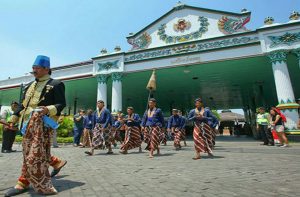YOGYAKARTA / JOGJA CITY TOUR

SULTAN PALACE / KERATON JOGJA
Yogyakarta Sultan Palace began to be established by Sultan Hamengku Buwono I a few months after the Agreement Giyanti in 1755. Location of this palace is said to be a former pesanggarahan named Garjitawati. This pesanggrahan is used to break the convoy of the kings of Mataram (Kartasura and Surakarta) who will be buried in Imogiri. Another version mentions the location of the palace is a spring, Umbul Pacethokan, which is in the middle of the forest Beringan. Prior to occupying Yogyakarta Palace, Sultan Hamengku Buwono I resided in Pesanggrahan Ambar Ketawang which now belongs to Gamping District of Sleman Regency.

Physically the palace of the Sultan of Yogyakarta has seven core complexes namely Siti Hinggil Ler (Northern Hall), Kamandhungan Ler (North Kamandhungan), Sri Manganti, Kedhaton, Kamagangan, Kamandhungan Kidul (South Kamandhungan), and Siti Hinggil Kidul (Balairung Selatan). In addition Yogyakarta Palace has a variety of cultural heritage both in the form of ceremonies and ancient and historic objects. On the other hand, Yogyakarta Palace is also a customary institution complete with its adat stakeholders. Therefore it is not surprising that the values of philosophy as well as mythology surround the Yogyakarta Palace. And for that reason in 1995 Komplek Keraton Ngayogyakarta Hadiningrat nominated to become one of UNESCO World Heritage Site.
WATER CASTLE / TAMANSARI
Taman Sari Water Castle, also known as Taman Sari, is the site of a former royal garden of the Sultanate of Yogyakarta. It is located about 2 km south within the grounds of the Kraton, Yogyakarta, Indonesia. Built in the mid-18th century, the Taman Sari had multiple functions, such as a resting area, a workshop, a meditation area, a defense area, and a hiding place.
Taman Sari consisted of four distinct areas: a large artificial lake with islands and pavilions located in the west, a bathing complex in the centre, a complex of pavilions and pools in the south, and a smaller lake in the east. Today only the central bathing complex is well preserved, while the other areas have been largely occupied by the Kampung Taman settlement.
Since 1995, the Yogyakarta Palace Complex including Taman Sari has been listed as a tentative World Heritage Site.
SONOBUDOYO MUSEUM
SONOBUDOYO MUSEUM is a museum of Javanese history and culture, including the building of classical Javanese architecture. This museum keeps a collection of Javanese culture and history which is considered the most complete after the National Museum of the Republic of Indonesia in Jakarta. In addition to Neolithic ceramics and bronze sculpture from the 8th century, this museum also stores several forms of wayang kulit, various ancient weapons (including keris), and Javanese masks.
Sonobudoyo Museum consists of two units. Sonobudoyo Museum Unit I is located at Jalan Trikora No. 6 Yogyakarta, while Unit II is located at nDalem Condrokiranan, Wijilan, to the east of the North Square of Sultan Palace.
The museum is located in the northern part of Alun-alon Lor from Yogyakarta Palace at night also show shadow puppet show in the form of its original appearance (by using Javanese language accompanied by Javanese gamelan music). This wayang kulit show is presented briefly from 08.00-10.00 pm on weekdays for foreign tourists and domestic tourists.
TIRTODIPURAN COMPLEX
There are two kind of Batik, the original batik and the print one, the original batik always handmade and use waxing process while the printing batik is printed using machine. In most market we can easily find printed batik, not so many places we can find original handmade batik. Tirtodipuran complex is a place where all the batik makers still maintain the original ways of making batik. Here we can see how they make batik and the whole process.
KOTAGEDE
Kotagede is regency located ± 6 kilometers from the southeastern Yogyakarta. Kotagede is considered as the origin of the existence of Islamic Mataram kindom founded in 1586 by Danang Sutowijoyo. A figure known as Raden Mas Ngabehi Lor-ing Pasar who became the first king of Islamic Mataram titled Panembahan Senopati ing Ngalaga. Kotagede is the capital of Islamic Mataram.
Silver processing of kotagede is a high valuable inheritance, which is already existed since Islamic Mataram’s establisment. It is started from the duty of the people toward the needs of nobleman at that time and then it is widely becoming one of commodity products ( souvenirs and gifts of Kotagede/ Yogyakarta ). Most people in Kotagede are craftsmen and manufacturers of silver crafts, as the results, it leads Kotagede known as Kota Perak ( Silver City ).
KASONGAN VILLAGE
Kasongan village is very famous with the clay and pottery in Yogyakarta, lots of shops selling souvenir with clay as main material.
MANDING VILLAGE
Manding village is a place where mostly people selling things made of leather. In the old days we can easily find genuine leather with cheap price, but nowadays we can find not only original leather but also the artificial ones.
PARANGTRITIS BEACH
Parangtritis is a tourist attraction that is quite famous in Yogyakarta compared to other beach objects such as Samas, Baron, Kukup, Krakal and Glagah. Parangtritis has a unique landscape that could not be found in other attractions, other than the big waves are also the mountains of sand around the beach, commonly called gumuk. This tourist attraction has been managed quite well, ranging from lodging facilities and markets that peddle typical souvenirs Parangtritis.
In Parangtritis there are also ATVs, horse and horse carts that can be hired to coast from east to west. Parangtritis is also famous for the lengenda community about the Queen of South Beach.